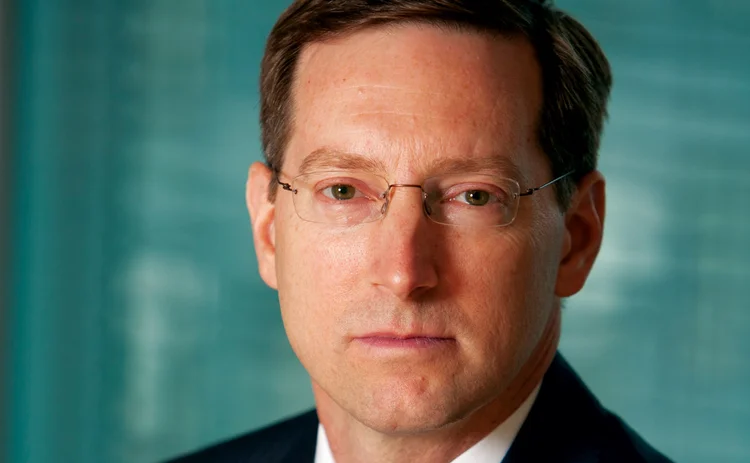
Derivatives house of the year: Citi
Citi cracks top three banks by commodity revenue and aggressively pursues big-ticket deals

Energy Risk Awards 2016
Citi's commodities business has been on an upward trajectory in recent years. As many other banks have scaled back their commodity market activities, Citi has done the opposite, aggressively buying their books and onboarding their former clients.
So far, the strategy has paid off. In 2015, Citi's commodities business had its fourth consecutive year of revenue growth, earning $750 million from so-called ‘principal transactions', up 27% from the year before, according to the bank's latest annual filing with the US Securities and Exchange Commission. In March, the London-based analytics and business intelligence firm Coalition announced Citi had tied JP Morgan for second place in terms of global commodity revenues in 2015, with Goldman Sachs holding on to the number one spot.
Cracking the top three has been a longstanding goal for Stuart Staley, Citi's London-based global head of commodities. "It's a very pleasing outcome and a recognition of the hard work of a lot of people," says Staley, who oversees roughly 240 people located in Calgary, Dubai, Hong Kong, Houston, London, New York, Singapore and Sydney.
After the 2008 financial crisis, Citi was one of the first US banks to slim down its commodities business and dial back on proprietary trading, selling off its oil-trading unit Phibro in 2009. Since then, Staley, who was appointed to his role in 2010, has navigated the business through multiple waves of regulatory change, including those arising from the US Dodd-Frank Act, the Volcker rule and Basel III capital requirements from the Basel Committee on Banking Supervision. The implications of Basel III for bank commodity desks have been particularly profound, as they have significantly increased the capital charges banks face for long-dated derivatives trades with less creditworthy clients.
"As we were redefining our strategy after the crisis, we had a fairly good sense of what the new capital rules were going to be, and we designed our strategy with those very much in mind," Staley says. "What you're seeing with some other banks is that they continued to operate strategies from the mid-2000s, even in the face of those rule changes. So, ultimately, it was more difficult for them to restructure their commodities businesses later in the game."
Banks that have cut back their commodity trading activities or exited the business altogether in recent years include Barclays, Credit Suisse and Deutsche Bank. Others, such as JP Morgan and Morgan Stanley, have sold off once-sizeable physical trading operations in order to narrow their focus around derivatives and risk management.
Staley says Citi seeks to use capital efficiently across its fixed income, currencies and commodities division; this allows the bank to stay active in markets such as interest rate and credit derivatives as well as in the products that his unit trades. "Within commodities, we run a pretty capital-light business model," he says. "We've never owned physical assets in our business and we've never engaged in certain activities that are very balance sheet-intensive."
At a time when liquidity has dried up in many long-dated or more rarefied commodity markets, such as US electricity traded at locations outside the major hubs, Citi's ability to provide liquidity stands out. Clients praise Citi as a very consistent, customer-friendly dealer.
"They have the ability to take on a lot of size, and they are generally a very good market-maker," says a member of the finance team at a US oil producer. "They also are very knowledgeable. They have very knowledgeable staff and very knowledgeable research groups that are accessible. Their marketers have a very in-depth knowledge of the market."
Across the spectrum
Citi's commodities business is impressively broad, spanning the globe and ranging across the spectrum from oil and natural gas to electricity and carbon credits to base and precious metals.
Crude oil continues to be a major part of the business. Though the bank will not confirm its involvement, Citi is reported to have been one of the seven banks that participated in Mexico's annual sovereign oil hedging programme in 2015, alongside Goldman and JP Morgan, among others. Carried out by Mexico's Ministry of Finance and Public Credit, the programme involves substantial volumes of put options on Mayan crude oil, a risk that can be challenging to lay off.
Another recent deal in Mexico illustrates Citi's strength in gas. In December 2015, Citi won a tender held by the country's state-owned electricity utility, Comisión Federal de Electricidad (CFE), for the delivery of liquefied natural gas (LNG) cargoes to the Manzanillo regasification facility on Mexico's Pacific Ocean coast. Citi was set to deliver five cargoes to Mexico in the first half of 2016 under the tender, with a sixth being delivered by another firm.
We remain active in the physical LNG markets, and we do a reasonable amount of business with both producers and consumers
Stuart Staley, Citi
The pricing in the CFE deal was linked to the Japan/Korea Marker (JKM), an LNG spot index published by New York-based price-reporting agency Platts. In addition to being one of the handful of banks that are active in moving physical LNG cargoes, Citi is a significant market-maker in derivatives linked to the JKM index. Liquidity in JKM swaps hit a record volume of 830 lots in February, according to Atlanta-based Ice, where most such swaps are cleared.
"We remain active in the physical LNG markets, and we do a reasonable amount of business with both producers and consumers, largely around structures that help them optimise their delivery obligations against production and/or consumption schedules," Staley says.
Metals are also a hot commodity for Citi. During the first half of 2015, Citi's London-based precious metals traders executed a significant gold transaction with a central bank that was looking to mobilise its bullion reserves to raise US dollar liquidity. The transaction, which also included an embedded derivatives hedge, is believed to be one of the largest over-the-counter precious metals trades executed last year. (For more details, see Precious metals house of the year: Citi.)
Power player
Electricity is one commodity where the retreat of banks has been especially pronounced. Barclays, Credit Suisse, Deutsche Bank and JP Morgan were all once sizeable players in US electricity markets but have now gone. That has left it much tougher for power companies to execute hedges, especially for long tenors.
Against that backdrop, Citi's persistence stands out. In 2015, Citi was the seventh-largest marketer of wholesale power in the US, selling 141.6 million megawatt-hours (MWh) - up 31.4% from the year before and more than any single other bank, according to Platts. Citi also boosted its client penetration last year by acquiring a book of power deals from Barclays, involving some 1,100 transactions in the market operated by the Electric Reliability Council of Texas (Ercot). The Ercot book, which Citi bought in March 2015, involved 25 clients and some $4.5 billion in notional positions, according to the bank.
By remaining active in North American power as its competitors exited, Citi was able to take advantage of the uptick in client activities that followed the so-called ‘polar vortex' two years ago. When frigid temperatures across the central and eastern US in January and February 2014 caused huge spikes in power prices, the volatility roiled many firms, particularly energy retailers, and the bitter experience made them more proactive about locking in prices in future.
"The winter of 2014 really had a pervasive impact on hedging behaviour throughout the North American markets," Staley says. "A lot of people got their fingers burned with unhedged positions in 2014, and one big theme we saw in that business last year was a return to more systematic hedging programmes."
In addition to a healthy flow business, Citi executed a number of complex structured deals with clients in the US electricity space. Perhaps the most high-profile of these was the 13-year physical power hedge that Citi provided to Facebook in July 2015, which will be used to secure a supply of green energy to a new data centre that the California-based social media company is building in Fort Worth, Texas. The deal is underpinned by an offsetting 13.5-year hedge that Citi provided to a wind farm some 90 miles away. (For more details, see Emissions house of the year: Citi.)
Citi's Houston-based originators have also worked closely with sponsors of natural gas-fired power plants being built to take advantage of inexpensive shale supplies. In recent weeks, for example, Citi wrote a five-year hedge to protect the revenues of the Tenaska Westmoreland Generating Station, a 925-megawatt gas-fired power plant project set to be constructed near Pittsburgh, Pennsylvania, by Tenaska, a Nebraska-based developer of electricity projects.
Citi's hedge for Tenaska was structured as a revenue put option, a type of customised hedging contract in which the writer of the option guarantees a minimum floor level for the future revenues of a power plant project. Such contracts have grown increasingly popular among US power companies in the past few years because they allow project sponsors to benefit from widening spark spreads; a spark spread is the differential between the price that a generator pays for gas and the price it gets for the power it produces.
The Tenaska hedge marked Citi's first revenue put with a US client. It supported a $780 million financing of the project, in which Citi was a member of the bank group that provided the financing.
Staley says the broad spectrum of commodity markets in which Citi provides risk management products is a key part of his team's strategy. "Part of our strategy is to keep as much breadth as possible in our commodities product offering, because in any given year, you're not sure where the activity is going to be," he says.
"You want to maintain enough breadth in your platform that, whatever happens, you can mobilise the resources to address it and serve the client needs that are coming from that end of the client spectrum. So that breadth is one of the things that has served us well."
Only users who have a paid subscription or are part of a corporate subscription are able to print or copy content.
To access these options, along with all other subscription benefits, please contact info@risk.net or view our subscription options here: http://subscriptions.risk.net/subscribe
You are currently unable to print this content. Please contact info@risk.net to find out more.
You are currently unable to copy this content. Please contact info@risk.net to find out more.
Copyright Infopro Digital Limited. All rights reserved.
As outlined in our terms and conditions, https://www.infopro-digital.com/terms-and-conditions/subscriptions/ (point 2.4), printing is limited to a single copy.
If you would like to purchase additional rights please email info@risk.net
Copyright Infopro Digital Limited. All rights reserved.
You may share this content using our article tools. As outlined in our terms and conditions, https://www.infopro-digital.com/terms-and-conditions/subscriptions/ (clause 2.4), an Authorised User may only make one copy of the materials for their own personal use. You must also comply with the restrictions in clause 2.5.
If you would like to purchase additional rights please email info@risk.net
More on Commodities
Energy Risk Asia Awards 2024: The winners
Winning firms adapt to change with exemplary risk management skills
Foreign funds are bulls in China’s onshore commodity futures
Growing participation from overseas investors is boosting liquidity in what’s already a boom market
Energy Risk Software Rankings 2024: IT demands increase amid rising risk
Heightened geopolitical and credit risk increase requirements on commodities software
Energy Risk Asia Awards 2023: The winners
Winning firms demonstrate resilience and robust risk management amid testing times
ION Commodities: addressing the market’s recent pain points
Energy Risk Software Rankings winner’s interview: ION Commodities
Energy Risk Commodity Rankings 2023: adapting to new market dynamics
Winners of the 2023 Commodity Rankings provided reliability when clients faced extreme change
Energy Risk Software Rankings 2023: managing uncertainty
Unpredictable markets make CTRM software choices key
Navigating the volatility and complexity of commodity markets
Commodity markets have experienced significant challenges since the Covid-19 pandemic, the conflict in Ukraine and the subsequent sanctions imposed on Russia. These unprecedented events have caused fluctuations in supply and demand, disrupted global…







